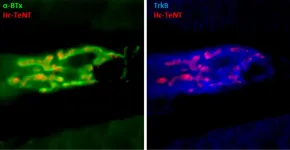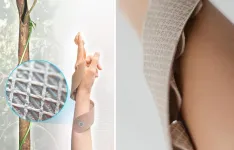(Press-News.org) ATLANTA--The American College of Rheumatology (ACR), in partnership with the Vasculitis Foundation (VF), released three new guidelines for the treatment and management of systemic vasculitis. Vasculitis is a group of about 20 rare diseases that have inflammation of blood vessels in common, which can restrict blood flow and damage vital organs. The three guidelines cover six forms of vasculitis, and a fourth guideline on Kawasaki disease will be released in the coming weeks.
"Many rheumatologists may have limited experience caring for patients with these diseases," said Dr. Sharon Chung, Director of the Vasculitis Clinic at the University of California, San Francisco, and the lead investigator of the guidelines. "However, the treatment options for patients with vasculitis have expanded in recent years. Thus, these guidelines provide practitioners evidence-based recommendations to help navigate the treatment path for their patients."
The guideline for giant cell arteritis (GCA) and Takayasu arteritis (TAK), both forms of large vessel vasculitis, provides a total of 42 recommendations and three ungraded position statements. The recommendations and statements address clinical questions relating to the use of diagnostic testing (including imaging), treatments, and surgical interventions in GCA and TAK. Recommendations for GCA support the use of glucocorticoid-sparing immunosuppressive agents and the use of imaging to identify large vessel involvement. Recommendations for TAK include the use of non-glucocorticoid immunosuppressive agents with glucocorticoids as initial therapy.
The guideline for polyarteritis nodosa (PAN), a medium vessel vasculitis, provides a total of 16 recommendations and one ungraded position statement. The recommendations support early treatment of severe PAN with cyclophosphamide and glucocorticoids, limiting toxicity through minimizing long-term exposure to both treatments, and the use of imaging and tissue biopsy for disease diagnosis. The recommendations endorse minimizing risk to the patient by using established therapy at the start of the disease and identify new areas where adjunctive therapy may be warranted.
The guideline for antineutrophil cytoplasmic antibody-associated vasculitis (AAV), a small vessel vasculitis, provides a total of 41 recommendations and 10 ungraded position statements for granulomatosis with polyangiitis (GPA), microscopic polyangiitis (MPA), and eosinophilic granulomatosis with polyangiitis (EGPA). According to the VF, the overall, worldwide incidence of AAV ranges from 0.5.-20 cases per 1 million people. In children, the incidence ranges from 0.45-6.4 cases per 1 million children per year. The guideline provides recommendations for remission induction and maintenance therapy as well as adjunctive treatment strategies in GPA, MPA, and EGPA. The recommendations include the use of rituximab for remission induction and maintenance in severe GPA and MPA and the use of mepolizumab in non-severe EGPA.
These new guidelines are the first produced and endorsed by the ACR and the VF. The organizations hope the guidelines will help providers better understand and treat the various forms of vasculitis.
"Different forms of vasculitis can have similar symptoms and treatment regimens; however, each disease is distinct, "said Joyce Kullman, Executive Director of the Vasculitis Foundation. "These guidelines will hopefully take some of the guesswork out of determining which treatments might work best for newly diagnosed patients, or patients who have been under treatment for a while without success."
As much as the guidelines highlight what evidence-based knowledge exists for the treatment and management of vasculitis, they also shine a light on what work needs to be done.
"We identified knowledge gaps that would benefit from additional research, like comparative effectiveness trials, longitudinal studies of imaging modalities, and identification of biomarkers to inform disease activity assessments," said Dr. Chung. "We hope this fuels research in these areas to facilitate patient care."
Like many other ACR guidelines, the three guidelines for vasculitis were developed using Grading of Recommendations Assessment, Development and Evaluation?(GRADE) methodology, which creates rigorous standards for judging the quality of the literature available and assigns strengths to the recommendations. Most of the recommendations in the guidelines are conditional because of the rarity of these diseases. The papers containing the full list of recommendations and supporting evidence is available at on the ACR website.
INFORMATION:
About the American College of Rheumatology
Founded in 1934, the American College of Rheumatology (ACR) is a not-for-profit, professional association committed to advancing the specialty of rheumatology that serves over 7,700 physicians, health professionals, and scientists worldwide. In doing so, the ACR offers education, research, advocacy and practice management support to help its members continue their innovative work and provide quality patient care. Rheumatology professionals are experts in the diagnosis, management and treatment of more than 100 different types of arthritis and rheumatic diseases. For more information, visit http://www.rheumatology.org.
About the Vasculitis Foundation
The Vasculitis Foundation (VF) is the international advocacy organization for people with vasculitis and has funded over 50 research studies, providing $2.7 million in funding. The VF is a central partner to a productive collaboration between patients, academic clinical investigators, and funding organizations conducting high-quality clinical research in vasculitis. Building upon the collective strength of the vasculitis community, the VF supports, inspires and empowers individuals with vasculitis and their families through a wide range of education, research, clinical, and awareness initiatives. For more information, visit http://www.vasculitisfoundation.org
Strokes, which occur when the blood supply to part of our brain is interrupted or reduced, are the leading cause of death and disability in the adult population. Among the patients who survive, 75% will experience difficulties carrying out daily activities independently and need long-term functional exercises and rehabilitation. But the outcomes using traditional rehabilitation equipment are poor. In addition, the motivation of patients to train is often low.
The Department of Neurology in Tongji Hospital, which is affiliated to Tongji Medical College at the Huazhong University of Science and Technology, is recognised in China for the quality of its scientific research and clinical strength. Similarly, Zhejiang BrainCo, Ltd., incubated by the Harvard Innovation Lab, is a market ...
Contrary to conventional thought, songbirds can taste sugar--even though songbirds are the descendants of meat-eating dinosaurs and are missing a key protein that allows humans and many other animals to taste sweetness. An international team investigated how many bird species can taste sweet and how far back that ability evolved. Their work was published today in the journal Science.
The researchers offered two species of songbirds a choice between sugar water and plain water--nectar-taking honeyeaters, as well as canaries, a grain-eating bird not known for consuming sweet foods. They also examined taste receptor responses sampled from a variety of other species. Regardless of whether their main ...
A team of physicists from the Harvard-MIT Center for Ultracold Atoms and other universities has developed a special type of quantum computer known as a programmable quantum simulator capable of operating with 256 quantum bits, or "qubits."
The system marks a major step toward building large-scale quantum machines that could be used to shed light on a host of complex quantum processes and eventually help bring about real-world breakthroughs in material science, communication technologies, finance, and many other fields, overcoming research hurdles that are beyond the capabilities of even the fastest supercomputers today. Qubits are the fundamental building blocks on which quantum computers ...
How does unicellular life transition to multicellular life? The research team of Professor Lutz Becks at the Limnological Institute of the University of Konstanz has taken a major step forward in explaining this very complex process. They were able to demonstrate - in collaboration with a colleague from the Alfred Wegner Institute (AWI) - that the unicellular green algae Chlamydomonas reinhardtii, over only 500 generations, develops mutations that provide the first step towards multicellular life. This experimentally confirmed a theory on the origin of multicellular life, which says that the evolution of cell groups and the subsequent steps towards multicellularity can only take place when cell groups are both better at reproduction and more likely to survive than single cells. ...
Although the giant panda is in practice a herbivore, its masticatory system functions differently from the other herbivores. Through the processes of natural selection, the giant panda's dietary preference has strongly impacted the evolution of its teeth and jaws. Researchers from the Institute of Dentistry at the University of Turku and the Biodiversity unit of the University of Turku together with researchers from the China Conservation and Research Center for Giant Panda (CCRCGP) have been the first in the world to solve the mystery of how the giant panda's special stomatognathic system functions.
The bamboo diet of the giant panda (Ailuropoda melanoleuca) has long been a ...
Pichia pastoris (syn. Komagataella phaffii), a model methylotrophic yeast, can easily achieve high density fermentation, and thus is considered as a promising chassis cell for efficient methanol biotransformation. However, inefficient gene editing and lack of synthetic biology tools hinder its metabolic engineering toward industrial application.
Recently, a research group led by Prof. ZHOU Yongjin from the Dalian Institute of Chemical Physics (DICP) of the Chinese Academy of Sciences established an efficient genetic engineering platform in Pichia pastoris.
The study was published in Nucleic Acids Research on July 1.
The researchers developed ...
Depression has been treated traditionally with inhibitors of serotonin reuptake in the central nervous system. These drugs do not come without side effects, such as lack of immediate therapeutic action, the need for daily doses and the danger of becoming addicted to some of these drugs. That is why scientists continue to work on new therapies to treat depression.
In 2019, an international group of researchers co-led by Dr Yousef Tizabe from the Howard University College of Medicine in Washington, D.C., and Professor José Aguilera from the Department of Biochemistry and Molecular Biology and the Institut de Neurociències ...
To splice or not to splice...
In an article published in the journal RNA, Karan Bedi, a bioinformatician in Mats Ljungman's lab, Department of Radiation Oncology at the University of Michigan Medical School, investigated the efficiency of splicing across different human cell types. The results were surprising in that the splicing process appears to be quite inefficient, leaving most intronic sequences untouched as the transcripts are being synthesized. The study also reports variable patterns between the different introns within a gene and across cell lines, and it further highlights ...
Researchers at the University of Freiburg and the University of Stuttgart have developed a new process for producing movable, self-adjusting materials systems with standard 3D-printers. These systems can undergo complex shape changes, contracting and expanding under the influence of moisture in a pre-programmed manner. The scientists modeled their development based on the movement mechanisms of the climbing plant known as the air potato (Dioscorea bulbifera). With their new method, the team has produced its first prototype: a forearm brace that adapts to the wearer and which can be further developed for medical applications. ...
Recess quality, not just the amount of time spent away from the classroom, plays a major role in whether children experience the full physical, mental and social-emotional benefits of recess, a new study from Oregon State University found.
"Not all recess is created equal," said William Massey, study author and an assistant professor in OSU's College of Public Health and Human Sciences. With schools returning to full-time in-person classes this fall, he said, "Now is a good time to rethink, 'How do we create schools that are more child-friendly?' I think ensuring quality access to play time and space during the school day is a way we can do that." ...







